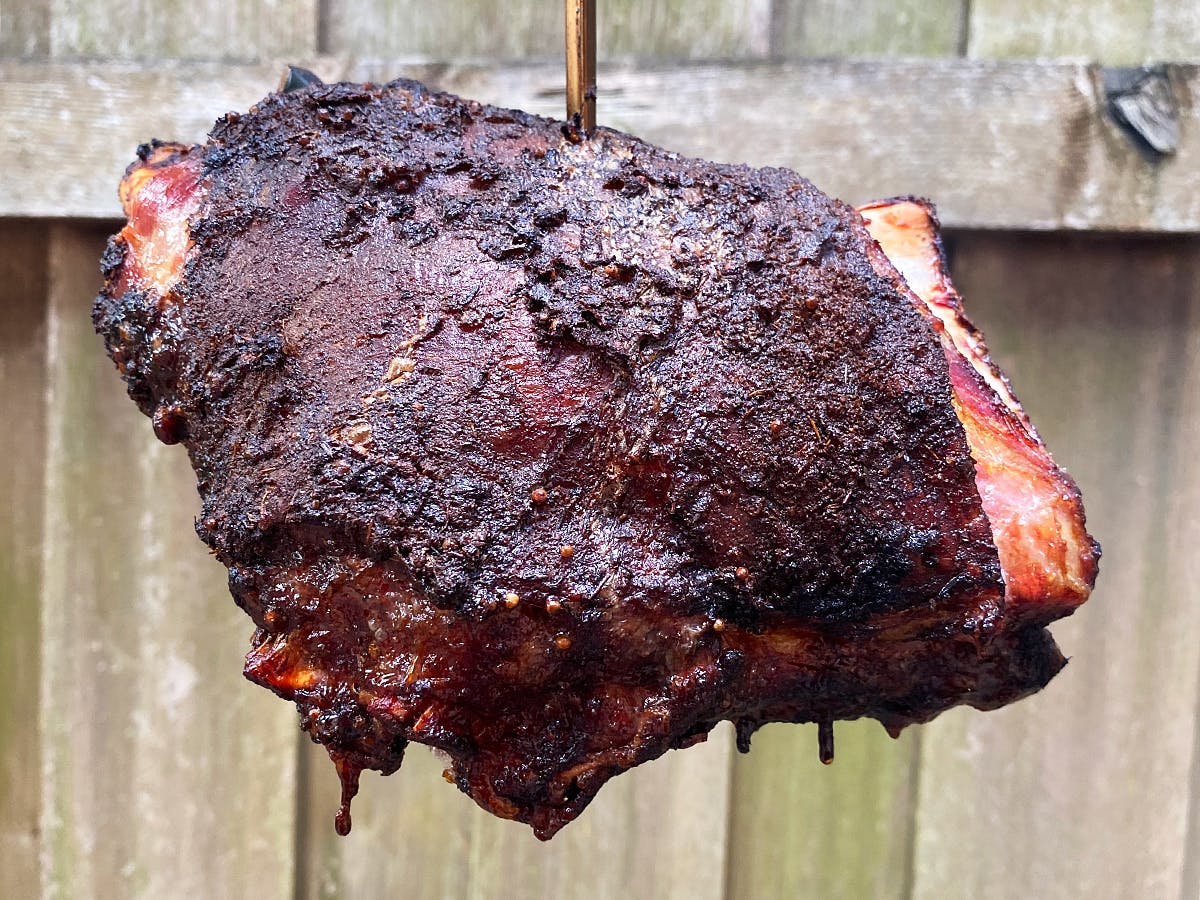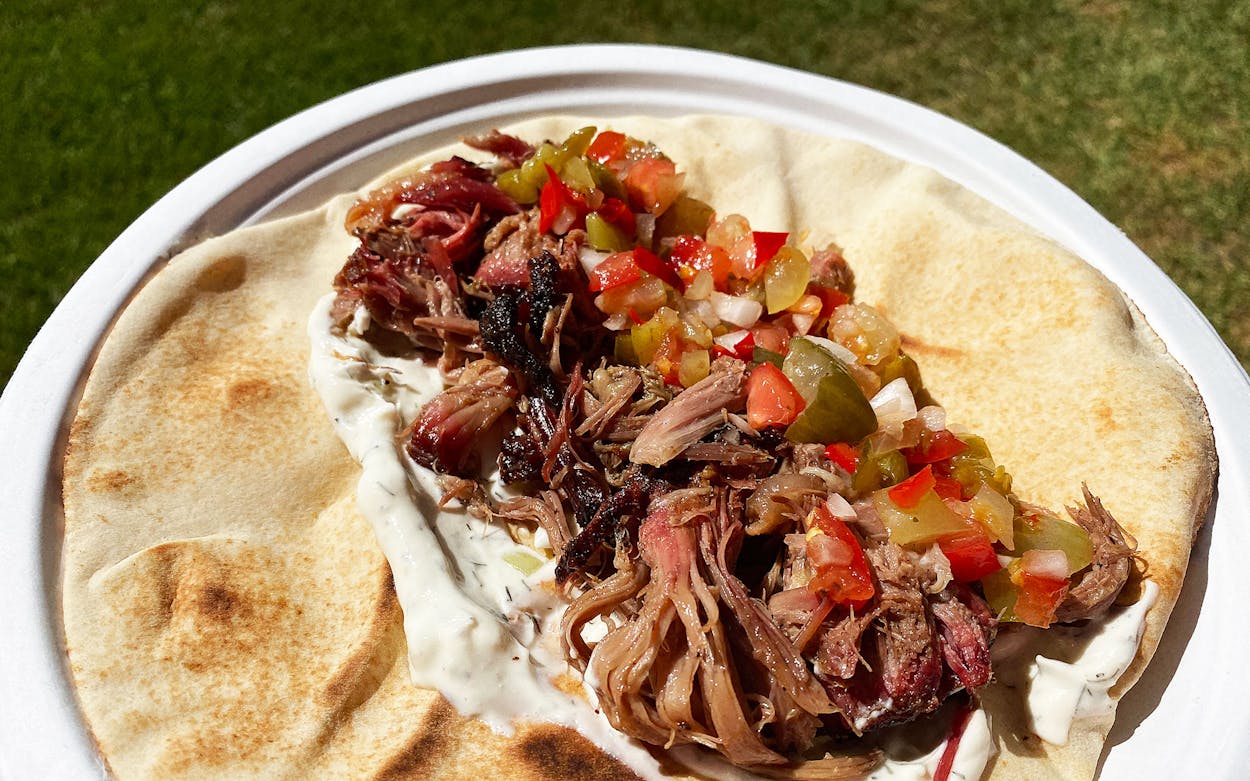The cattle industry so dominates the identity of Texas ranching that it might be surprising to learn that we lead the nation in sheep production. The 740,000 head currently in the state is actually quite a ways off from the 10 million that resided here during the peak of the wool industry in 1943. Back then, the bushy Rambouillet breed, descended from the famous Merino sheep of Spain, was the unquestioned king. Nowadays there’s just not as big a market for wool, so Texas sheep ranchers are trending toward breeds raised for meat, like Dorper. One of those ranchers is Houston Simmons, who started the Margaritas Sueño Meat Company in Menard less than two years ago.
Simmons has a breeding stock of 130 sheep and almost as many goats on properties in Kimble and Menard counties, southeast of San Angelo. He doesn’t supply meat to any restaurants (yet), but he has delivered a whole goat to Denver for an event at Hank’s Texas Barbecue. Frozen cuts of his pasture-raised lamb are available for shipping, so I ordered a couple square-cut lamb shoulders from him a few weeks ago.
I had originally asked for mutton. In doing some research on the meat served at Texas community barbecues of the late nineteenth and early twentieth centuries, I learned that three proteins were repeated far more often than any other: beef, pork, and mutton. I was curious what real mutton tasted like, but Simmons explained the difference between lamb and mutton as well as the difference between the meat sheep and the wool sheep that were probably served during those barbecues. “I’ve had funky, skunky sheep before,” he tells me, noting that it wasn’t a positive attribute. His description reminded me of my first bite from a leg of lamb at a friend’s house for dinner when I was kid. The flavor matched the odor of a sheep barn at the county fair, and I’m not making a manure joke.
Simmons guesses I probably ate meat from a sheep raised for wool. The same lanolin that provides moisture (and the trademark smell) to the wool also flavors the meat. “The old story you always heard was that if you touched the wool to the meat, that lanolin will get on it and make it really funky,” he says. Those wool sheep were likely slaughtered at an older age after they’d provided a few years’ worth of wool, and because of their age, the meat would be referred to as mutton. Sheep raised for meat like the Dorper breed (his have some Barbado mixed in as well) are known as “hair breeds” and don’t have the lanolin flavor. They are also harvested younger, but how young do they have to be to be considered lamb rather than mutton?
Maybe you’ve seen meat sold as “spring lamb.” That would be very young, around four months old, and would be the equivalent to cabrito or veal. The general cutoff for regular lamb is one year old. Lambs at Margaritas Sueño are born in October and November, and are harvested at anywhere between ten and fourteen months old. Rather than using the age, a weight of 100–115 pounds is his target, because, Simmons said, “The yield on the carcass is at its peak at that weight.” That can take longer to reach for pasture-raised lambs like the ones sold by Simmons. Lambs finished in feedlots grow more quickly and normally reach that weight by the time they’re nine to ten months old.

Because of their age, the sheep sent to feedlots can easily be defined as lamb rather than mutton. Simmons doesn’t see the need for a distinction just because his sheep are a month or two beyond that one-year threshold. Besides, he said, he prefers the flavor of pasture-raised lamb. He and a friend took four lambs from their herd. The friend sent two lambs to the feedlot, and Simmons finished the other two on grass. It took Simmons three months longer to get his lambs to the same weight, and then they tasted them side-by-side. Their conclusion was, “[the feedlot] makes it bigger, but it waters down the flavor of the meat.” If you cannot buy from him, Simmons said the Capra Foods lamb (out of Goldthwaite) offered at grocery stores is pasture-raised Dorper sheep similar to what he has.
Mutton was once so popular in Texas that the name remains in the few barbecue joints that still serve it. Most of them serve the ribs, and while the menu might say mutton, they’re smoking lamb. Some of the best “mutton” barbecue can be found at Sam’s Bar-B-Que in Austin, Gonzales Food Market in Gonzales, Davila’s BBQ in Seguin, and the multiple locations of Southside Market.
Simmons prefers the T-bone lamb chop if he’s getting his pick of cuts, but admits he tries not to “get high on my own supply.” He eats plenty of lamb and goat, but the cuts he gets are usually the ones other people don’t want to buy, unlike the chops. Simmons is also fond of wild game he gets from the hunting tours he leads on his property, and he said he rarely eats beef or pork. For barbecue, Simmons likes the square-cut lamb shoulder, which has the first four ribs attached. That’s what he sent me to smoke.
Smoked Lamb Shoulder
1 square-cut, bone-in lamb shoulder
Kosher salt
Yellow mustard
Low-salt barbecue rub
The night before cooking, apply kosher salt liberally to all surfaces of the lamb shoulder. Use 1.5 percent of the weight of the meat to determine your salt amount if unsure. Let the salted meat sit uncovered in the refrigerator for 8 to 24 hours.
Prepare a smoker at 275 degrees. While heating the smoker, remove the lamb shoulder from the refrigerator and cover with a thin coating of yellow mustard. Apply barbecue rub to cover all surfaces, and place into the preheated smoker. You can use a standard offset smoker, but I cooked two shoulders and had better results with hanging them inside a Pit Barrel Cooker. It took 3 hours for a 3-pound shoulder to reach 195 degrees. I could have let it go longer in the pit to finish, but I wanted it to shred very easily, so I wrapped it in foil and moved it to a 200-degree oven for another hour. After a 30-minute rest outside the oven, I shredded the entire shoulder, discarding the bones and any hard fat, of course.
Serve the meat on its own with a Kentucky black barbecue sauce on the side for dipping, or do what I did and place it in a warm pita with tzatziki and some pickle de gallo. Either way, it’s a good way to get yourself out of a beef and pork barbecue rut and support Texas ranchers at the same time.
- More About:
- Recipes
- BBQ Recipes








